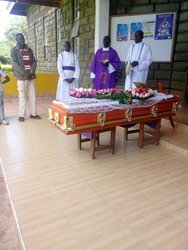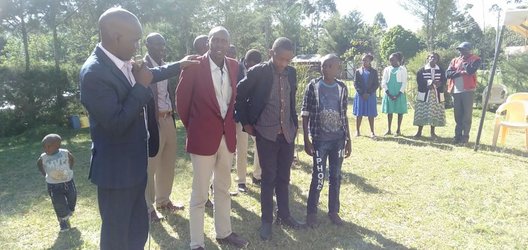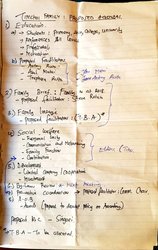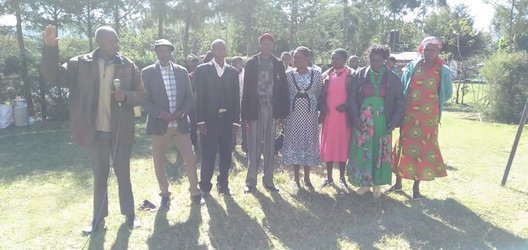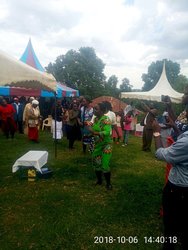|
|
About KAPTIMCHOI FAMILY
Before Learning about the origin of
Timchoi family, First lets discuss a bit
more understand of the
kalenji sub-groups. (source
https://en.wikipedia.org/wiki/Kalenjin_peo
ple#History)
ABOUT THE NANDI PEOPLE
The Nandi are part of the Kalenjin ethnic
group found in East Africa. They
traditionally have lived
and still form the majority in the
highland areas of the former Rift Valley
Province of Kenya, in
what is today Nandi County. They speak the
Nandi dialect of the Kalenjin language.
According to the Kalenjin narrative of
origin, the Nandi section was formed from
the separation of
what had been a combined group of Kipsigis
and Nandi. They had been living at Rongai
near Nakuru as
a united group for about a century before
they were forced to separate due to
antagonistic
environmental factors, notably droughts
and invasion of the Maasai from Uasin
Gishu.The Kipsigis
moved southwards, settling around Kericho
while the Nandi continued west and settled
at Aldai.[8]
Radiocarbon dating of archaeological
excavations done in Rongai (Deloraine)
have ranged in date from
around 985 to 1300 A.D and have been
associated with the early development
phase of the Sirikwa
culture. From here the culture radiated
outwards toward the western highlands, the
Mt. Elgon region
and possibly into Uganda
The existence of the Nandi as a tribe
dates from about the beginning of the
seventeenth century.
Within Nandi tradition it is understood as
a distinct process through which various
Kalenjin clans
came to occupy the present day Nandi
county. The traditional Nandi account is
that the first
settlers in their country came from Elgon
during the time of the Maina and formed
the Kipoiis clan;
a name that possibly means 'the spirits'.
They were led by a man named Kakipoch,
founder of the
Nandi section of the Kalenjin and are said
to have settled in the emet (county) of
Aldai in
south-western Nandi. One of the earliest
Bororiet was named after Kakipoch and the
site of his
grave, still shown on Chepilat hill in
Aldai was marked by the stump of an
ancient olive tree. The
account of his burial is that his body was
laid on ox-hide, together with his
possessions, and left
for the hyenas.
Social organization
The system of social organisation was
broadly similar to that of other Kalenjin
communities.The
Nandi territory was divided into six
counties known as emet (pl. emotinwek).
These were Wareng,
located to the north, Mosop in the North
East,Tindiret in the East, Soiin & Pelkut
in the South,
Aldai & Chesumei in the west and Emgwen in
the center.
The emotinwek were divided into districts
known as bororiet (borororisiek) and these
were divided
into villages known as kokwet
(kokwotinwek). The Nandi administrative
system was unique among the
Kalenjin in having the bororiosiek
administrative layer.
Within the wider Kalenjin administrative
system, the Kokwet was the most
significant political and
judicial unit in terms of day to day
issues. The kokwet elders were the local
authority for
allocating land for cultivation, they were
also the body to whom the ordinary member
of the tribe
would look for a decision in a dispute or
problem which defied solution by direct
agreement between
the parties. Membership of the kokwet
council was acquired by seniority and
personality and within
it decisions were taken by a small number
of elders whose authority derived from
their natural
powers of leadership.Among the Nandi
however, the Bororiet was the most
significant institution and
the political system revolved around it.
Social institutions
The Nandi social system divided the male
sex into boys, warriors and elders. The
female sex is
divided into girls and married women. The
first stage began at birth and continued
till initiation.
All boys who were circumcised together
were said to belong to the same "Ibinda"
and once the young
men of a particular ibinda came of age,
they were tasked with protecting the
tribal lands and the
society, the period when they were in
charge of protection of the society was
known as the age of
that ibinda. Historically, the Nandi had
eight cyclical age-sets or ibinwek,
however they dropped
one for a total of seven. Legend has it
that the members of this "ibinda" were
wiped out in war. For
fear of a recurrence, the community
decided to retire the age-set.
The order of Nandi ibinwek is given below.
Maina
Chumo
Sawe
Kipkoimet
Korongoro
Kaplelach
Kipnyigei
Nyongi
Defeat of the Arabs
The earliest recorded mention of Arab
caravans in Nandi oral tradition date to
the 1850s during the
time when the Sawe ibinda (age-set) were
warriors. The contact was antagonistic
with raids on the
caravans carried out by Nandi warriors. By
1854, the name Mararma ("to ornament a
dress") had been
conveyed upon a sub-set of the Sawe
possibly as a result of the very
successful raiding of Arab
caravans or perhaps as a result of the
major defeat at Kipsoboi. These were good
years for the Nandi.
The Nandi warriors had never encountered a
foe armed with firearms before and they
had to develop
new military tactics to overcome the
effectiveness of a large number of
firearms. Like the Masai,
the warriors drew the enemy's fire by a
sudden rush at which time they went "go to
ground." Then the
warriors charged the caravan porters
before the muzzle loading weapons could be
recharged. The
porters bolted into the reloading riflemen
followed closely by the Nandi warriors and
in this
confusion, the Nandi warriors could spear
the panicked men. This tactic would be
deployed
effectively until the battle of Kimondi in
1895.
Three Nandi warriors, date unknown
Part of the reason for the Nandi success
was the limited access. The easiest
approach was from the
north-east, but a caravan had to travel
two or three days before reaching
principal Nandi
settlements. This evidently was not
preferable as the Arab caravans diverted
east to Kavirondo and
Mumias where food and protection was
located.
Due to the casualties to the caravans,
direct trade increasingly became
difficult. Caravans rarely
entered or camped in Nandi and a strange
"middle man" system evolved after the
1850s. Trusted Sotik
and Dorobo agents were employed to act as
"middle men" who would trade ivory and
other coastal goods
for cattle to the Nandi for a large
commission.[10]
"Enterprising Arab traders hoping to
circumvent this arrangement often fell
victims to a Nandi ploy.
A few old Nandi warriors would meet the
armed caravan and tell them that a large
supply of ivory was
only two or three days journey from the
caravan. However, the Nandi were only
willing to entertain a
small Arab party to negotiate a trade.
Dutifully, a party of twenty men would be
dispatched with
cloth, wire, and other trade goods only to
be ambushed by the Nandi and massacred."
"Another ruse
used by the Nandi was to send a small
party of warriors to lead the prospective
caravan into the
depths of Nandi by the wrong road and then
conduct a night attack. The Arab traders
even attempted a
tactic that had worked with other tribes,
blood brotherhood. This consisted of
sitting opposite one
another, cutting the back of each other's
hand and sucking the blood from one
another's hand. The
Nandi held no credence to such a foreign
ceremony, and it only became another ploy
to easily acquire
coastal goods."[11]
Frustrated by failures, the Arab traders
attempted one last tactic. They
established a series of
fortified stations at Kimatke, Kibigori,
Chemelil, Kipsoboi, and Kobujoi, and began
a campaign of
intimidation. Donkeys were let loose to
trample the millet fields, Nandi warriors
were humilitated,
Nandi boys were imprisoned, and Nandi
women and girls were compromised. At
Kipsoboi four Nandi
shields were propped against a tree and
the Nandi were offered the chance to shoot
arrows into the
shields. Once this was accomplished, the
Arabs fired musket balls through the
shields that had
stopped the arrows. The Arabs then poured
gruel over the attending Nandi's heads and
shaved off
their cherished locks.
The Nandi warriors had had enough. They
sought permission from the Kaptalam
Orkoiyot to kill the
Arabs. He gave permission, and the post
was stormed. Some accounts credit the
Orkoiyot's charms with
making the defender's ammunition
disappear, while others credit the error
of the garrison commander
to provide ammunition to the riflemen.
Regardless of the reason, the garrison at
Kipsoboi was
destroyed. The Nandi kiptaiyat (raiding
bands) then successfully attacked and
slaughtered the
garrison at Kobujoi. This was enough to
force the Arab traders to withdraw from
Nandi and to avoid
the area.
The defeat of the Arabs created the "Nandi
legend." The Nandi were undefeatable.
Porters could not
be hired and expeditions could not be
launched into Nandi for nearly forty
years. The Nandi warriors
stood proudly aloof from the events that
were swirling around them confident to
defend their
independence.[12]
Resistance to British rule
Main article: Nandi Resistance
Koitalel Arap Samoei Mausoleum and Museum
in Nandi Hills, Kenya
By the later decades of the 19th century,
at the time when the early European
explorers started
advancing into the interior of Kenya,
Nandi territory was a closed country
Thompson in 1883 was
warned to avoid the country of the Nandi,
who were known for attacks on strangers
and caravans that
would attempt to scale the great massif of
the Mau.[13]
Matson, in his account of the resistance,
shows 'how the irresponsible actions of
two British
traders, Dick and West, quickly upset the
precarious modus vivendi between the Nandi
and incoming
British'.[14] This would cause more than a
decade of conflict led on the Nandi side
by Koitalel Arap
Samoei, the Nandi Orkoiyot at the time.
The conflict would end on 19 October 1905,
when Col Richard Meinertzhagen called for
a peace
meeting. Instead, Meinertzhagen killed
Koitalel and his entourage in cold blood
on the grounds of
what is now Nandi Bears Club.
Sosten Saina, grand-nephew of one of Arap
Samoei's bodyguards notes that "There were
about 22 of
them who went for a meeting with the
‘mzungu’ that day. Koitalel Arap Samoei
had been advised not to
shake hands because if he did, that would
give him away as the leader. But he
extended his hand and
was shot immediately". Shortly after this
event, the Nandi Resistance ended and
Nandi was
incorporated into the British East Africa
Protectorate.[15]
Colonial period
Nandi Protest of 1923
A number of factors taking place in the
early 1920s led to what has come to be
termed the Nandi
Protest[16] or Uprisings of 1923. It was
the first expression of organized
resistance by the Nandi
since the wars of 1905-06.
Primary contributing factors were the land
alienation of 1920 and a steep increase in
taxation,
taxation tripled between 1909 and 1920 and
because of a change in collection date,
two taxes were
collected in 1921. The Kipsigis and Nandi
refused to pay and this amount was
deferred to 1922.
Further, due to fears of a spread of
rinderpest following an outbreak, a stock
quarantine was
imposed on the Nandi Reserve between 1921
and 1923. The Nandi, prevented from
selling stock outside
the Reserve, had no cash, and taxes had to
go unpaid. Normally, grain shortages in
Nandi were met by
selling stock and buying grain. The
quarantine made this impossible. The labor
conscription that
took place under the Northey Circulars
only added to the bitterness against the
colonial government.
All these things contributed to a buildup
of antagonism and unrest toward the
government between
1920 and 1923. In 1923, the saget ab eito
(sacrifice of the ox), a historically
significant ceremony
where leadership of the community was
transferred between generations, was to
take place. This
ceremony had always been followed by an
increased rate of cattle raiding as the
now formally
recognized warrior age-set sought to prove
its prowess. The approach to a saget ab
eito thus
witnessed expressions of military fervour
and for the ceremony all Nandi males would
gather in one
place.
Alarmed at the prospect and as there was
also organized protest among the Kikuyu
and Luo at that
time, the colonial government came to
believe that the Orkoiyot was planning to
use the occasion of
the Saget ab eito of 1923 as a cover under
which to gather forces for a massive
military uprising.
On October 16, 1923, several days before
the scheduled date for the saget ab eito,
The Orkoiyot
Barsirian Arap Manyei and four other
elders were arrested and deported to Meru.
Permission to hold
the ceremony was withdrawn and it did not
take place, nor has it ever taken place
since.[17] The
Orkoiyot Barsirian Arap Manyei would spend
the next forty years in political
detention, becoming
Kenya's, and possibly Africa's, longest
serving political prisoner.[18] |

LOADING! Please wait ...
Getting Around
There are several ways to browse the family tree. The Tree View graphically shows the relationship of selected person to their kin. The Family View shows the person you have selected in the center, with his/her photo on the left and notes on the right. Above are the father and mother and below are the children. The Ancestor Chart shows the person you have selected in the left, with the photograph above and children below. On the right are the parents, grandparents and great-grandparents. The Descendant Chart shows the person you have selected in the left, with the photograph and parents below. On the right are the children, grandchildren and great-grandchildren. Do you know who your second cousins are? Try the Kinship Relationships Tool. Your site can generate various Reports for each name in your family tree. You can select a name from the list on the top-right menu bar.
In addition to the charts and reports you have Photo Albums, the Events list and the Relationships tool. Family photographs are organized in the Photo Index. Each Album's photographs are accompanied by a caption. To enlarge a photograph just click on it. Keep up with the family birthdays and anniversaries in the Events list. Birthdays and Anniversaries of living persons are listed by month. Want to know how you are related to anybody ? Check out the Relationships tool. |
|
|


